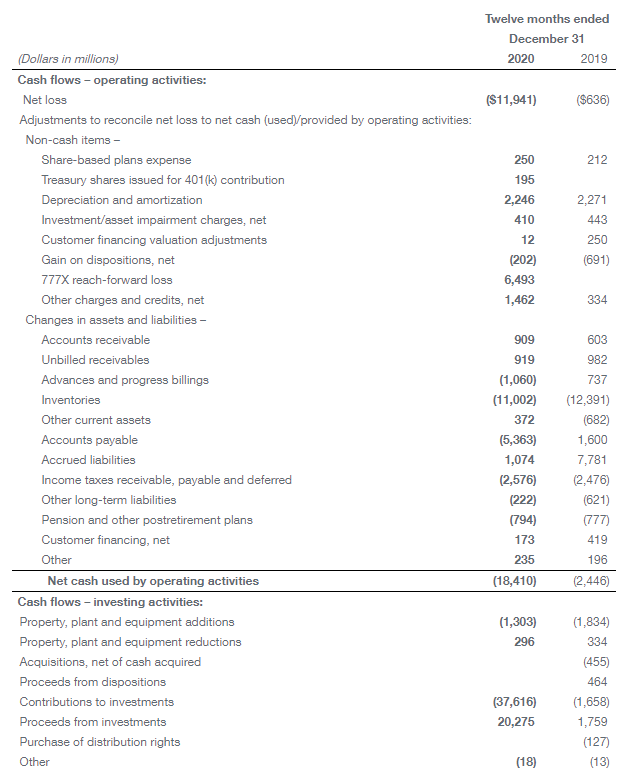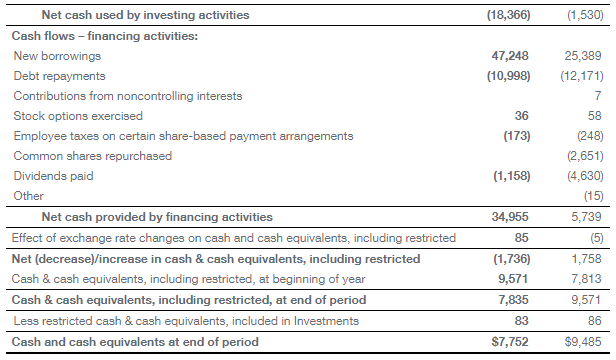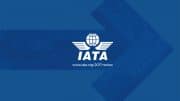CHICAGO, Jan. 27, 2021 /PRNewswire/ —
Fourth Quarter 2020
- Financial results significantly impacted by COVID-19, 737 MAX grounding, and commercial widebody programs
- 777X program recorded $6.5 billion pre-tax charge; first delivery expected in late 2023
- 737 MAX began receiving regulatory approval to resume operations and restarted eliveries
- Revenue of $15.3 billion, GAAP loss per share of ($14.65) and core (non-GAAP)* loss per share of ($15.25)
Full-Year 2020
- Revenue of $58.2 billion, GAAP loss per share of ($20.88) and core (non-GAAP)* loss per share of ($23.25)
- Operating cash flow of ($18.4) billion; cash and marketable securities of $25.6 billion
- Total backlog of $363 billion, including more than 4,000 commercial airplanes
- Strengthening safety processes, improving performance, managing liquidity and transforming for the future

*Non-GAAP measure; complete definitions of Boeing’s non-GAAP measures are on page 6, “Non-GAAP Measures Disclosures.”
The Boeing Company [NYSE: BA] reported fourth-quarter revenue of $15.3 billion, reflecting lower commercial deliveries and services volume primarily due to COVID-19 as well as 787 production issues, partially offset by a lower 737 MAX customer considerations charge in the quarter compared to the same period last year (Table 1). GAAP loss per share of ($14.65) and core loss per share (non-GAAP)* of ($15.25) reflected a $6.5 billion pre-tax charge on the 777X program and a tax valuation allowance, partially offset by a lower 737 MAX customer considerations charge. Boeing recorded operating cash flow of ($4.0) billion.
“2020 was a year of profound societal and global disruption which significantly constrained our industry. The deep impact of the pandemic on commercial air travel, coupled with the 737 MAX grounding, challenged our results. I am proud of the resilience and dedication our global team demonstrated in this environment as we strengthened our safety processes, adapted to our market and supported our customers, suppliers, communities and each other,” said Boeing President and Chief Executive Officer Dave Calhoun. “Our balanced portfolio of diverse defense, space and services programs continues to provide important stability as we lay the foundation for our recovery. While the impact of COVID-19 presents continued challenges for commercial aerospace into 2021, we remain confident in our future, squarely-focused on safety, quality and transparency as we rebuild trust and transform our business.”
The return to service of the 737 MAX in the U.S. and several other markets was an important step, and Boeing continues to follow the lead of global regulators and support its customers. Since the FAA’s approval to return to operations, Boeing has delivered over 40 737 MAX aircraft and five airlines have safely returned their fleets to service as of January 25, 2021, safely flying more than 2,700 revenue flights and approximately 5,500 flight hours.
Boeing now anticipates that the first 777X delivery will occur in late 2023. This schedule, and the associated financial impact, reflect a number of factors, including an updated assessment of global certification requirements, the company’s latest assessment of COVID-19 impacts on market demand, and discussions with its customers with respect to aircraft delivery timing.
The company continues to progress through its business transformation effort across five key areas including its infrastructure footprint, overhead and organizational structure, portfolio and investment mix, supply chain health and operational excellence. Boeing will continue these actions in 2021 to preserve liquidity, adapt to the new market, improve performance, sustain key investments and transform its business to be more productive, resilient and competitive for the long term.

*Non-GAAP measure; complete definitions of Boeing’s non-GAAP measures are on page 6, “Non-GAAP Measures Disclosures.”
Operating cash flow was ($4.0) billion in the quarter, reflecting lower commercial deliveries and services volume, as well as timing of receipts and expenditures (Table 2).

1 Marketable securities consists primarily of time deposits due within one year classified as “short-term investments.”
Cash and investments in marketable securities decreased to $25.6 billion, compared to $27.1 billion at the beginning of the quarter, primarily driven by operating cash outflows partially offset by changes in the debt balance (Table 3).
Total company backlog at quarter-end was $363 billion.
Segment Results
Commercial Airplanes

Commercial Airplanes fourth-quarter revenue decreased to $4.7 billion, driven by lower widebody delivery volume due to COVID-19 impacts as well as 787 production issues, partially offset by higher 737 deliveries and a lower 737 MAX customer consideration charge in the quarter compared to the same period last year (Table 4). Fourth-quarter operating margin decreased to (161.8) percent, primarily driven by a $6.5 billion pre-tax charge on the 777X program, lower delivery volume, and $468 million of abnormal production costs related to the 737 program, partially offset by a lower 737 MAX customer consideration charge.
Commercial Airplanes production rate assumptions reflect the continued impacts of COVID-19 on commercial demand, and the company will continue to assess them on an ongoing basis. The 737 program is currently producing at a low rate and expects to gradually increase production to 31 per month in early 2022 with further gradual increases to correspond with market demand. The 787 program plans to transition its production rate to 5 per month in March 2021, at which point 787 final assembly will be consolidated to Boeing South Carolina.
As discussed above, Commercial Airplanes now expects first delivery of the 777X to occur in late 2023 and has recorded a $6.5 billion reach-forward loss on the 777X program. Among the factors contributing to the revised first delivery schedule and reach-forward loss are an updated assessment of certification requirements based on ongoing communication with civil aviation authorities, an updated assessment of market demand based on continued dialogue with customers, resulting adjustments to production rates and the program accounting quantity, increased change incorporation costs, and associated customer and supply chain impacts. The production rate expectation for the combined 777/777X program remains at 2 per month in 2021.
Commercial Airplanes captured orders for 75 737 aircraft from Ryanair and eight 777 freighters from DHL, as well as a commitment for 23 737 aircraft from Alaska Airlines. Commercial Airplanes delivered 59 airplanes during the quarter, and backlog included over 4,000 airplanes valued at $282 billion.
Defense, Space & Security.

Defense, Space & Security fourth-quarter revenue increased to $6.8 billion, primarily driven by higher volume on fighter programs and the rest of the portfolio as well as a charge on the Commercial Crew program in the same period last year (Table 5). Fourth-quarter operating margin increased to 7.4 percent reflecting more favorable performance on multiple programs compared with the same period last year, partially offset by a $275 million pre-tax charge on the KC-46A Tanker program primarily due to production inefficiencies including impacts of COVID-19 disruption.
During the quarter, Defense, Space & Security was awarded contracts for two KC-46A aircraft for Japan and AEW&C upgrades for the Republic of Korea Air Force. Defense, Space & Security achieved first flight of the MQ-25 unmanned aircraft with an aerial refueling store and demonstrated ski-jump launch capability of the F/A-18 Super Hornet for the Indian Navy. Also in the quarter, Defense, Space & Security completed engineering design review for the Wideband Global SATCOM-11+ communications satellite and critical design review of the Space Launch System Exploration Upper Stage for NASA.
Backlog at Defense, Space & Security was $61 billion, of which 32 percent represents orders from customers outside the U.S.
Global Services

Global Services fourth-quarter revenue decreased to $3.7 billion, driven by lower commercial services volume due to COVID-19 (Table 6). Fourth-quarter operating margin decreased to 3.8 percent primarily due to lower commercial services volume and $290 million of pre-tax charges related to asset impairments driven by COVID-19.
During the quarter, Global Services was awarded a Performance Based Logistics contract for the Republic of Singapore Air Force F-15SG fleet, secured a F-15 spares and logistics support contract with the Qatar Emiri Air Force, and was selected to provide P-8A training for the Royal New Zealand Air Force. Global Services also announced a 10-year digital services agreement with Frontier Airlines.
Additional Financial Information

At quarter-end, Boeing Capital’s net portfolio balance was $2.0 billion. The change in revenue from other unallocated items and eliminations was primarily due to the timing of eliminations for intercompany aircraft deliveries. Other unallocated items and eliminations included a $744 million charge related to the previously announced agreement between Boeing and the U.S. Department of Justice in January 2021. Interest and debt expense increased due to higher debt balances. The fourth quarter 2020 effective tax rate primarily reflects an additional valuation allowance on certain deferred income tax assets, partially offset by the benefit of the five year net operating loss carryback provision in the Coronavirus Aid, Relief, and Economic Security (CARES) Act.
Non-GAAP Measures Disclosures
We supplement the reporting of our financial information determined under Generally Accepted Accounting Principles in the United States of America (GAAP) with certain non-GAAP financial information. The non-GAAP financial information presented excludes certain significant items that may not be indicative of, or are unrelated to, results from our ongoing business operations. We believe that these non-GAAP measures provide investors with additional insight into the company’s ongoing business performance. These non-GAAP measures should not be considered in isolation or as a substitute for the related GAAP measures, and other companies may define such measures differently. We encourage investors to review our financial statements and publicly-filed reports in their entirety and not to rely on any single financial measure. The following definitions are provided:
Core Operating Earnings, Core Operating Margin and Core Earnings Per Share
Core operating earnings is defined as GAAP earnings from operations excluding the FAS/CAS service cost adjustment. The FAS/CAS service cost adjustment represents the difference between the FAS pension and postretirement service costs calculated under GAAP and costs allocated to the business segments. Core operating margin is defined as core operating earnings expressed as a percentage of revenue. Core earnings per share is defined as GAAP diluted earnings per share excluding the net earnings per share impact of the FAS/CAS service cost adjustment and Non-operating pension and postretirement expenses. Non-operating pension and postretirement expenses represent the components of net periodic benefit costs other than service cost. Pension costs, comprising service and prior service costs computed in accordance with GAAP are allocated to Commercial Airplanes and BGS businesses supporting commercial customers. Pension costs allocated to BDS and BGS businesses supporting government customers are computed in accordance with U.S. Government Cost Accounting Standards (CAS), which employ different actuarial assumptions and accounting conventions than GAAP. CAS costs are allocable to government contracts. Other postretirement benefit costs are allocated to all business segments based on CAS, which is generally based on benefits paid. Management uses core operating earnings, core operating margin and core earnings per share for purposes of evaluating and forecasting underlying business performance. Management believes these core earnings measures provide investors additional insights into operational performance as they exclude non-service pension and post-retirement costs, which primarily represent costs driven by market factors and costs not allocable to government contracts. A reconciliation between the GAAP and non-GAAP measures is provided on pages 13-14.
Free Cash Flow
Free cash flow is GAAP operating cash flow reduced by capital expenditures for property, plant and equipment. Management believes free cash flow provides investors with an important perspective on the cash available for shareholders, debt repayment, and acquisitions after making the capital investments required to support ongoing business operations and long term value creation. Free cash flow does not represent the residual cash flow available for discretionary expenditures as it excludes certain mandatory expenditures such as repayment of maturing debt. Management uses free cash flow as a measure to assess both business performance and overall liquidity. Table 2 provides a reconciliation of free cash flow to GAAP operating cash flow.
Caution Concerning Forward-Looking Statements
This press release contains “forward-looking statements” within the meaning of the Private Securities Litigation Reform Act of 1995. Words such as “may,” “should,” “expects,” “intends,” “projects,” “plans,” “believes,” “estimates,” “targets,” “anticipates,” and similar expressions generally identify these forward-looking statements. Examples of forward-looking statements include statements relating to our future financial condition and operating results, as well as any other statement that does not directly relate to any historical or current fact. Forward-looking statements are based on expectations and assumptions that we believe to be reasonable when made, but that may not prove to be accurate. These statements are not guarantees and are subject to risks, uncertainties, and changes in circumstances that are difficult to predict. Many factors could cause actual results to differ materially and adversely from these forward-looking statements. Among these factors are risks related to: (1) the COVID-19 pandemic and related government actions, including with respect to our operations, our liquidity, the health of our customers and suppliers, and future demand for our products and services; (2) the 737 MAX, including the timing and conditions of 737 MAX regulatory approvals, lower than planned production rates and/or delivery rates, and increased considerations to customers and suppliers, (3) general conditions in the economy and our industry, including those due to regulatory changes; (4) our reliance on our commercial airline customers; (5) the overall health of our aircraft production system, planned commercial aircraft production rate changes, our commercial development and derivative aircraft programs, and our aircraft being subject to stringent performance and reliability standards; (6) changing budget and appropriation levels and acquisition priorities of the U.S. government; (7) our dependence on U.S. government contracts; (8) our reliance on fixed-price contracts; (9) our reliance on cost-type contracts; (10) uncertainties concerning contracts that include in-orbit incentive payments; (11) our dependence on our subcontractors and suppliers, as well as the availability of raw materials; (12) changes in accounting estimates; (13) changes in the competitive landscape in our markets; (14) our non-U.S. operations, including sales to non-U.S. customers; (15) threats to the security of our or our customers’ information; (16) potential adverse developments in new or pending litigation and/or government investigations; (17) customer and aircraft concentration in our customer financing portfolio; (18) changes in our ability to obtain debt financing on commercially reasonable terms and at competitive rates; (19) realizing the anticipated benefits of mergers, acquisitions, joint ventures/strategic alliances or divestitures; (20) the adequacy of our insurance coverage to cover significant risk exposures; (21) potential business disruptions, including those related to physical security threats, information technology or cyber-attacks, epidemics, sanctions or natural disasters; (22) work stoppages or other labor disruptions; (23) substantial pension and other postretirement benefit obligations; and (24) potential environmental liabilities. Additional information concerning these and other factors can be found in our filings with the Securities and Exchange Commission, including our most recent Annual Report on Form 10-K, Quarterly Reports on Form 10-Q and Current Reports on Form 8-K. Any forward-looking statement speaks only as of the date on which it is made, and we assume no obligation to update or revise any forward-looking statement, whether as a result of new information, future events, or otherwise, except as required by law.
The Boeing Company and Subsidiaries
Consolidated Statements of Operations
(Unaudited)

The Boeing Company and Subsidiaries
Consolidated Statements of Financial Position
(Unaudited)

The Boeing Compagny and Subsidiaries
Consolidated Statements of Cash Flows
(unaudited)


The Boeing Company and Subsidiaries
Summary of Business Segment Data
(unaudited)
Effective at the beginning of 2020, certain programs were realigned between our Defense, Space & Security segment and Unallocated items, eliminations and other. Business segment data for 2019 has been adjusted to reflect the realignment.

The Boeing Company and Subsidiaries
Operating and Financial Data
(Unaudited)


The Boeing Company and Subsidiaries
Reconciliation of Non-GAAP Measures
(Unaudited)

The Boeing Company and Subsidiaries
Reconciliation of Non-GAAP Measures
(Unaudited)
The tables provided below reconcile the non-GAAP financial measures core operating loss, core operating margin, and core loss per share with the most directly comparable GAAP financial measures, loss from operations, operating margin, and diluted loss per share. See page 6 of this release for additional information on the use of these non-GAAP financial measures.

Source : Boeing














Be the first to comment on "Boeing Reports Fourth-Quarter Results"